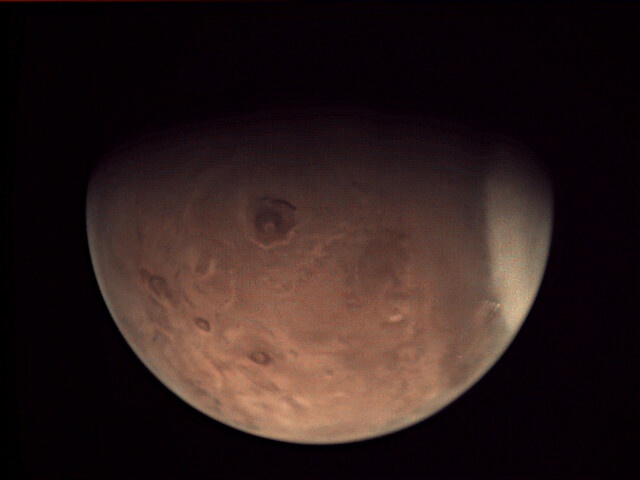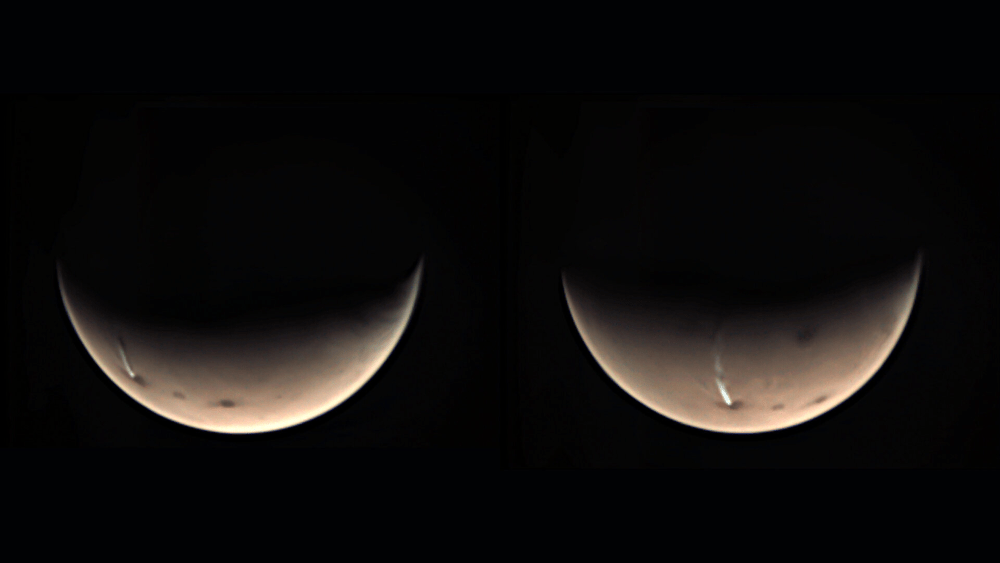Every Spring a Single Cloud Forms at one of Mars’ Tallest Mountains and Only Lasts for a few Hours
By Andy Tomaswick
Sometimes even forgotten pieces of technology can lead to completely new science. That was the case recently when scientists at the University of the Basque Country used an almost forgotten camera on the Mars Express to take a breathtaking video of a recurring cloud on the top of Arsia Mons.
Scientists have known of the cloud’s existence for a number of years. However, due to the eccentricities of the orbits of Martian satellites and the Martian climate, it has been impossible to consistently image the cloud well enough to make sense of it. Mysteries abound, including why it only appears over Arsia Mons and none of the other volcanoes in the region. Why does it appear only in springtime? And why does it fade so quickly?
Credit: ESA / GCP / UPV / EHU Bilbao
The video the team at the University of the Basque Country took might now answer all of those questions, but it does provide more insight into the cloud’s formation and potential cause. To capture that video, the team utilized a long dormant tool on Mars Express – the Visual Monitoring Camera (VMC).
Originally the VMC was designed for a single purpose. Back in 2003 it visually watched the failed Beagle 2 lander descend to the surface of the red planet. After completing its primary mission, it was turned off and sat unused for more than a decade. Finally in 2016 the camera was turned back on as part of ESA’s outreach efforts. Essentially the agency planned to use it as a webcam watching Mars.

Credit: ESA
More recently, the camera was released for scientific use rather than simply outreach. That’s when scientists really started to consider what they could actually do with a webcam on Mars.
One main advantage of the VMC is that it has a wide field of view, so while the resolution of its images might not be great, it can observe a large area of the Martian surface at any one time. That ability is in stark contrast with more pinpointed instruments whose high resolution means they have a relatively narrow field of view.
Credit: Weather Channel Youtube
That wide field of view would be extremely handy when trying to observe very large features, such as the cloud the appears at the top of Arsia Mons. So the team at the University of the Basque Country, led by Dr. Jorge Hernández Bernal, decided to use VMC as a center point of a data collecting effort focused on the cloud.
Other resources were brought in to help bolster the amount of data collected, including some of Mars Express’ own instruments – OMEGA and HRSC as well as data from MAVEN, MRO, Viking 2 and the Mars Orbiter Mission. They collated data all the way back to the 1970s in order to truly understand how the cloud forms and how it changes over time.

Image Credit: ESA/GCP/UPV/EHU Bilbao
What resulted from all that data was a much better understanding of one of the more unique weather phenomena on Mars. The cloud is 1800 km long and 150 km across, making it the largest cloud ever seen on Mars that was caused by topographical features. It grows extremely quickly at over 600 km/h and at a height of about 45 km. After being anchored to Arsia Mons itself for a number of hours, the cloud eventually moves westward before dissipating in the late morning, after only having existed on a daily basis for about two and a half hours.
Being able to capture a large part of the Martian surface all at once was key to this discovery, as there were very few instruments orbiting Mars that would be able to see the cloud in its entirety during the brief daily window when it appears. Data from the VMC was therefore instrumental in helping scientists understand this unique meteorological feature. With luck, it won’t be the last transient phenomena that the long disused camera will be able to capture on Mars.
Learn More:
ESA – Mars Express unlocks the secrets of curious cloud
JGR Planets – An Extremely Elongated Cloud Over Arsia Mons Volcano On Mars
UT – There’s a Funny Cloud on Mars, Perched Right at the Arsia Mons Volcano. Don’t Get Too Excited, Though, it’s not an Eruption
UT – Weather Forecasting on Mars Likely to be Trickier Than on Earth
Sci-News – Martian Orbiters Observe Extremely Elongated Cloud over Arsia Mons Volcano
Lead Image:
Details of the elongated cloud that forms over Arsia Mons
Credit: ESA
The post Every Spring a Single Cloud Forms at one of Mars’ Tallest Mountains and Only Lasts for a few Hours appeared first on Universe Today.

March 21, 2021 at 06:53PM
via Universe Today read more...

Post a Comment